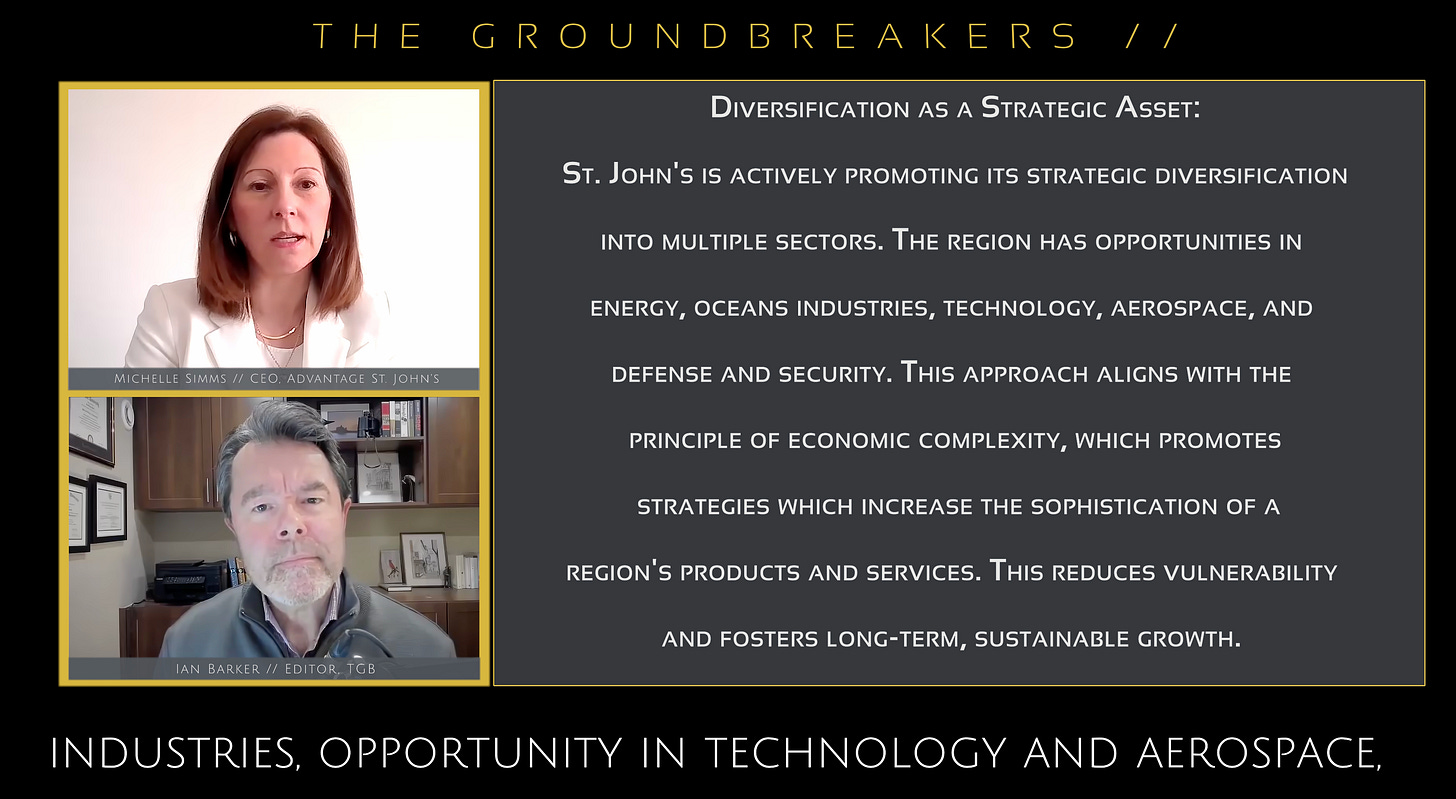Michelle Simms, CEO of Advantage St. John’s, provides compelling insight into how St. John’s, the capital of Newfoundland and Labrador, is building a dynamic, resilient innovation ecosystem. The city and surrounding region taps into its own strengths, history, and collaborative spirit to create long-term competitive advantage, creating a powerful talent attractant and compelling reason for local talent to stay and build. This video, together with Part 1, provides a valuable case study for any community leader seeking to build a more robust, innovative and resilient economy.
Key Takeaways from St. John’s
Here’s why this video is a must-watch for anyone involved in innovation and economic development:
Strength in Numbers: St. John’s is building its future by fostering collaboration across municipalities, post-secondary institutions, and various business sectors. This collective approach is a key to navigating economic challenges and creating a stronger whole.
Resilience as a Core Competency: The region’s history of overcoming challenges, from the collapse of the fishery to oil price fluctuations, has created a culture of resilience. This isn’t just a byproduct of tough times; it’s a strategic differentiator that attracts talent and investment.
From Oil to Innovation: The video reveals how the city’s oil and gas industry became a direct catalyst for its tech sector. The need to solve complex problems in a harsh offshore environment led to the creation of new technologies and a highly skilled workforce, demonstrating how a region can leverage its existing strengths to develop new, sophisticated industries.
A Billion-Dollar Success Story: Discover how Verafin, a company that started in a local incubator, was acquired by NASDAQ for $2.75 billion, marking the largest tech acquisition in Canadian history. The most remarkable part? The company and its founders stayed in St. John’s, proving that you don’t have to leave home to achieve global success.
From the Video. LINK Analysis: St. John’s, Newfoundland and Labrador
The Power of Integrated Leadership: St. John’s is building a leadership coalition that brings together over 40 diverse organizations—from municipalities and universities to innovation centers and chambers of commerce. This is more than just a collaboration; it’s a way to ensure all actors are aligned towards a common vision and can leverage their unique resources to create innovative solutions for complex challenges -- Benefitting the entire region.
Create a self-sustaining, upward spiral of growth: The St. John’s strategy is designed to create a virtuous innovation cycle. By bringing a diverse group of
stakeholders together to create a shared plan, they are fostering intentional interaction and collaboration. This will lead to the creation and transfer of new knowledge, which in turn will attract more talent and investment to the region, and ultimately lead to a more diversified and complex economy. This cyclical process ensures that each success feeds the next, creating a long-term, resilient path to prosperity.
Infrastructure for People, Not Just Projects: Economic growth isn’t just about GDP. It’s about creating a place people want to live and work. St. John’s recognizes that infrastructure extends beyond labs and co-working spaces to include the social and cultural fabric of the community. By focusing on downtowns and central areas, they are investing in the essential services and amenities that directly improve citizens’ lives. This focus on the “built environment” is a critical enabler for innovation and a powerful differentiator.
In a world of economic uncertainty, a community’s outlook and collective optimism are powerful economic drivers. A sense of hope can inspire long-term investment and civic engagement, which are hard to measure but critical for
sustained growth. This isn’t just a feel-good exercise. It is a strategic move that attracts talent, inspires entrepreneurs, and signals a community that is on a positive trajectory.
Create a self-sustaining, upward spiral of growth: The St. John’s strategy is designed to create a virtuous innovation cycle. By bringing a diverse group of
stakeholders together to create a shared plan, they are fostering intentional interaction and collaboration. This will lead to the creation and transfer of new knowledge, which in turn will attract more talent and investment to the region, and ultimately lead to a more diversified and complex economy. This cyclical process ensures that each success feeds the next, creating a long-term, resilient path to prosperity.
Collaboration as a Strategic Imperative: St. John’s success is a direct result of different actors working together to find solutions. By actively managing
interconnectedness and encouraging different sectors to “lean on others,” a region can overcome its limitations and create a dynamic, unique economic environment. When faced with adversity, the most important step is to find partners and work together, because this partnership strategy is an engine of innovation and resilience.
A Culture of Mutual Support: The St. John’s approach highlights a culture where “the province, communities, individuals, or companies have had to lean on others” to get through challenging times. A collaborative ethos is a powerful differentiator that can be leveraged as an economic asset. Regions can focus on fostering this culture by creating platforms and processes which facilitate interaction and trust, allowing knowledge to spill over and new ideas to form.
A Legacy of Continued Innovation: The success of Verafin includes the legacy it leaves for the next generation of innovators. Capital generated from the acquisition can be reinvested into the ecosystem. More importantly, the experienced founders, employees, and investors from this major success story become mentors and role models, passing on their know-how and inspiring the
next wave of startups. This creates a self-sustaining, evolving ecosystem where new knowledge is continuously created and applied, fueling a virtuous innovation cycle.
Diversification as a Strategic Asset: St. John’s is actively promoting its strategic diversification into multiple sectors. The region has opportunities in energy, oceans industries, technology, aerospace, and defense and security. This approach aligns with the principle of economic complexity, which promotes strategies which increase the sophistication of a region’s products and services. This reduces vulnerability and fosters long-term, sustainable growth.









